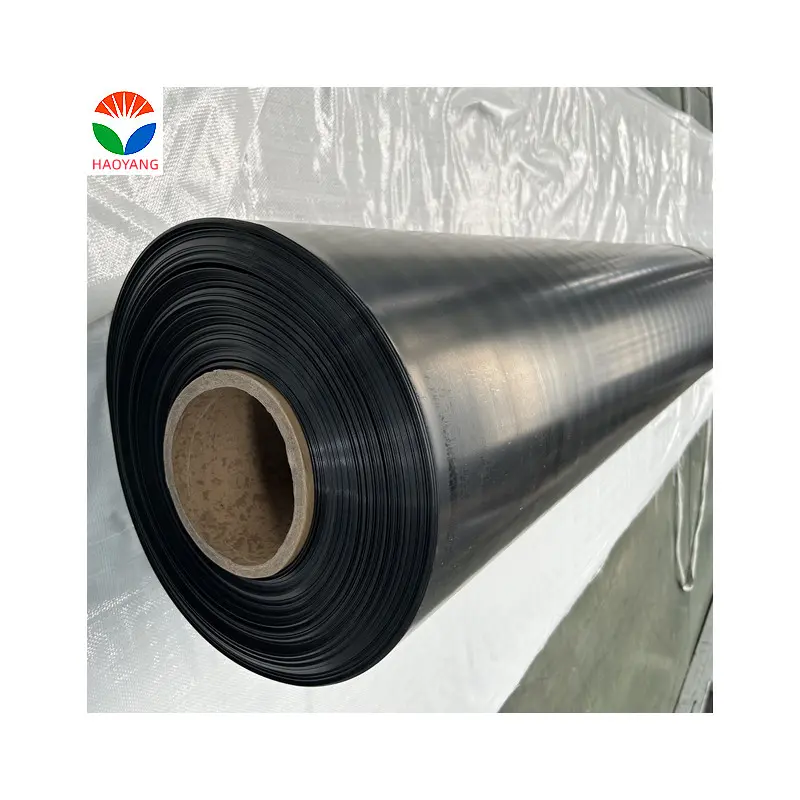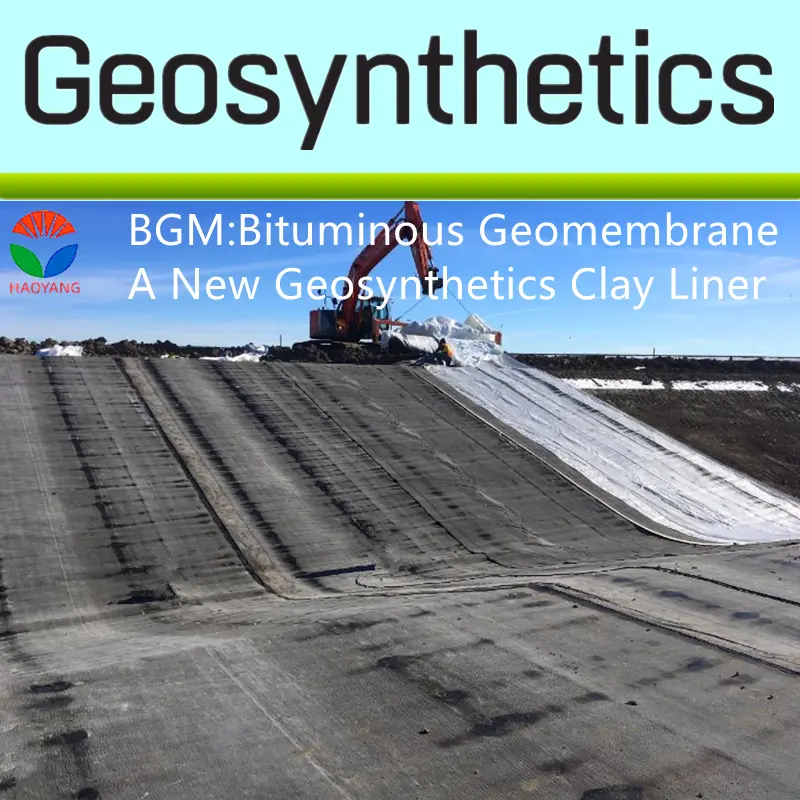1. What is BGM?
Bituminous Geomembrane (BGM) is a type of geomembrane consisting of a reinforcing geotextile to provide mechanical strength and elastomeric bitumen to provide impermeability. Other components such as sand, a glass fleece, and/or a polyester film can be incorporated into the layers of a BGM. Bituminous geomembranes are differentiated from bituminous waterproofing materials used in buildings due in part to their wide roll width, which can exceed 5m, and their substantial thickness of up to 6.0mm.These features are designed for environmental protection and mining applications.
2. The history of BGM
Bitumen emulsions applied to polypropylene geotextiles were reported to have been used in the Nawada heap leach mining installation as early as 1973. Published literature describing the modern development of asphalt geomembranes dates back to the first envisioned dual-liner systems. Proposed in 1974 by geosynthetic pioneer JP Giroud. This new asphalt geomembrane is made by in-situ spraying of hot asphalt onto polyester geotextile. Shortly after these early installations, factory-made BGM was developed to plant asphalt impregnated into the geotextile, allowing for high standards of quality control. By 1988, spray-on backing tracks had completely fallen out of favor.
3. Inherent characteristics of BGM
Typical Intrinsic Properties of Bituminous Geomembranes | ||||
Property | Standard | Units | Value | Application Relevance |
Coefficient of Linear Thermal Expansion | ASTM D 696 | °C⁻¹ | 10−5 | A low coefficient of thermal expansion prevents problematic wrinkling with exposure to temperature variation. |
Density | ASTM D 792-20 | g/cm³ | 1.27 | High density (greater than water) is useful for submersed applications, limiting wind uplift, and safer installation in windy conditions. |
Elongation at Break | ASTM D 7275 | % | >60 | Elongation capacity combined with tensile strength provides toughness allowing light traffic during installation and accommodating differential settlement in service. |
Friction Angle (sand side) | NF EN 495-2 | ° | 39.5 | A high friction angle allows for safer installation and greater slope stability. |
Cold Bending - Lowest Temperature | ASTM D 746 | °C | -20 | Cold bending relates to the ability to use and manipulate the geomembrane in cold conditions. |
Water Permeability | ASTM E 96 | m/s | < 6.10⁻¹⁴ | The extremely low water permeability of a BGM aligns with the high standards typical of geomembranes. |
Gas Permeability (Methane Transmission Rate) | ASTM D 1434-82 | m³/(m2.d.atm) | < 2.10⁻⁴ | A useful index for gas barrier applications. |
Note: The above data comes from the Internet Wikipedia.
4. BGM famous project cases
Partial List of Noteworthy BGM Projects | |||
Project | Country | Type | Date Completed |
Diavik Diamond Mine | Canada | Mining | 2007 |
Kittilä mine | Finland | Mining | 2007, 2008 |
Las Bambas copper mine | Peru | Mining | 2012, 2014 |
Dolores mine | Mexico | Mining | 2013, 2014, 2017, 2020 |
St. George Regional Airport | United States | Transportation | 2019 |
Pench Right Canal | India | Water | 2019, 2022 |
Stockton Mine | New Zealand | Mining | 2022 |

5. What is the difference between BGM and HDPE?
What is the difference between BGM and HDPE?
Bituminous Geomembrane (BGM) and High-Density Polyethylene (HDPE) are both materials used for containment applications, but they have distinct differences in composition, properties, and applications:
Composition:
BGM: Bituminous Geomembrane is composed of bituminous materials, such as asphalt or coal tar, blended with polymers to create a flexible membrane. The bituminous component provides flexibility, while the polymers enhance strength and durability.
HDPE: High-Density Polyethylene is a type of thermoplastic polymer derived from petroleum. It is characterized by its high strength, chemical resistance, and flexibility.
Properties:
BGM: Bituminous Geomembranes typically offer good flexibility, puncture resistance, and moderate chemical resistance. They are suitable for applications where flexibility is crucial, such as in uneven subgrades.
HDPE: High-Density Polyethylene is known for its high tensile strength, excellent chemical resistance, and long-term durability. It can withstand exposure to a wide range of chemicals, UV radiation, and harsh environmental conditions.
Applications:
BGM: Bituminous Geomembranes are commonly used in applications such as lining reservoirs, landfills, ponds, and secondary containment systems. They are suitable for moderate chemical containment needs and applications where flexibility is important.
HDPE: High-Density Polyethylene is widely used in various containment applications, including landfills, mining operations, wastewater treatment facilities, and environmental remediation projects. It is preferred for its superior chemical resistance and long-term performance.
Installation:
BGM: Bituminous Geomembranes are typically installed by rolling out the membrane over the prepared subgrade and then seaming the panels together using heat or adhesive techniques. Proper surface preparation and quality control during installation are crucial.
HDPE: High-Density Polyethylene is installed using heat fusion welding techniques, which create strong, homogeneous seams that resist leakage. HDPE liners are typically prefabricated and then installed on-site.
In summary, while both BGM and HDPE serve similar purposes in containment applications, they have distinct properties and characteristics that make them suitable for different scenarios. BGM offers flexibility and moderate chemical resistance, while HDPE provides superior strength, chemical resistance, and long-term durability. The choice between BGM and HDPE depends on specific project requirements, including site conditions, containment needs, regulatory requirements, and cost considerations.
6. Can BGM replace HDPE?
Whether Bituminous Geomembrane (BGM) can replace High-Density Polyethylene (HDPE) depends on various factors, including the specific requirements of the project, site conditions, containment needs, regulatory considerations, and cost considerations. Here are some key points to consider when evaluating whether BGM can replace HDPE:
Chemical Resistance: HDPE typically offers superior chemical resistance compared to BGM. If the containment application involves exposure to a wide range of chemicals or aggressive substances, HDPE may be the preferred choice due to its ability to withstand chemical exposure over the long term.
Durability and Longevity: HDPE is known for its long-term durability and resistance to environmental factors such as UV radiation, temperature fluctuations, and mechanical stress. If the project requires a long-term containment solution with minimal maintenance and a lifespan of several decades, HDPE may be more suitable than BGM.
Flexibility and Installation: BGM is generally more flexible than HDPE, making it suitable for applications where the subgrade is uneven or where flexibility is crucial during installation. However, HDPE liners can be prefabricated and installed using heat fusion welding techniques, creating strong, homogeneous seams that resist leakage.
Cost Considerations: The cost of materials, installation, and maintenance should also be taken into account when comparing BGM and HDPE. While BGM may be more cost-effective in some cases, particularly for projects with less demanding containment requirements or where flexibility is important, HDPE's long-term durability and performance may justify the higher initial investment.
Regulatory Compliance: Ensure that the selected geomembrane meets regulatory requirements and standards for the specific application and site conditions. Regulatory agencies may have specific guidelines regarding the use of geomembranes, including requirements for chemical resistance, seam integrity, and environmental impact.
In some cases, Bituminous Geomembrane (BGM) may be a suitable alternative to High-Density Polyethylene (HDPE) for containment applications, particularly in situations where flexibility, moderate chemical resistance, and cost-effectiveness are prioritized over long-term durability. However, for applications requiring superior chemical resistance, long-term performance, and regulatory compliance, HDPE may be the preferred choice. It's essential to carefully evaluate the specific needs of each project and consult with industry professionals to determine the most suitable geomembrane solution.
7. Your reliable partner for high-quality geomembrane solutions
Our company specializes in providing top-quality BGM and HDPE geomembranes, offering tailored solutions to meet diverse project needs. With years of industry experience, we assist clients in selecting the most suitable geomembrane solution, ensuring optimal performance and value. Our product range includes , but is not limited to, BGM and HDPE geomembranes. Committed to customer satisfaction, we collaborate closely with clients to understand their project requirements and deliver solutions that exceed expectations. With stringent quality control processes and state-of-the-art manufacturing facilities, we ensure that our geomembranes meet the highest industry standards. Trust us to be your reliable partner for high-quality geomembrane solutions.
![]() 0.75 Double-sided smooth HDPE geomembrane.pdf
0.75 Double-sided smooth HDPE geomembrane.pdf
![]() 1mm Single-texture HDPE geomembrane.pdf
1mm Single-texture HDPE geomembrane.pdf
![]() 2mm Single-texture HDPE geomembrane.pdf
2mm Single-texture HDPE geomembrane.pdf
![]() 1 Double-sided smooth HDPE geomembrane.pdf
1 Double-sided smooth HDPE geomembrane.pdf

897.webp)
942.webp)
237.webp)